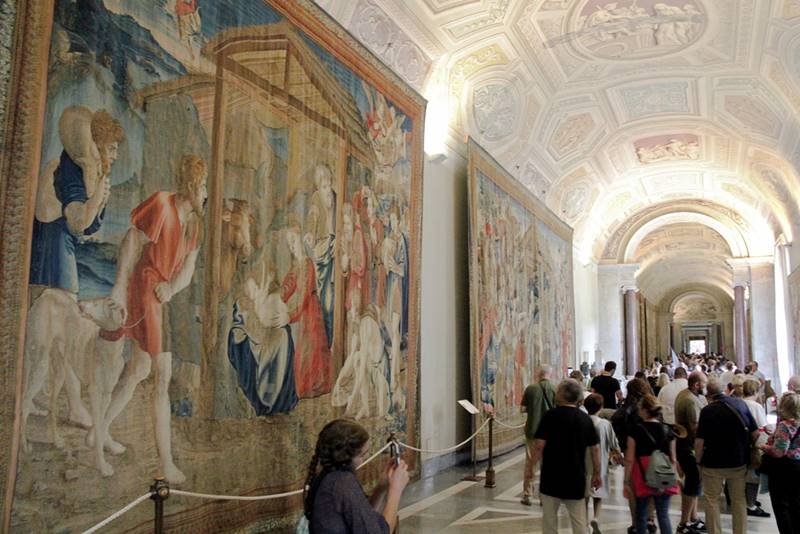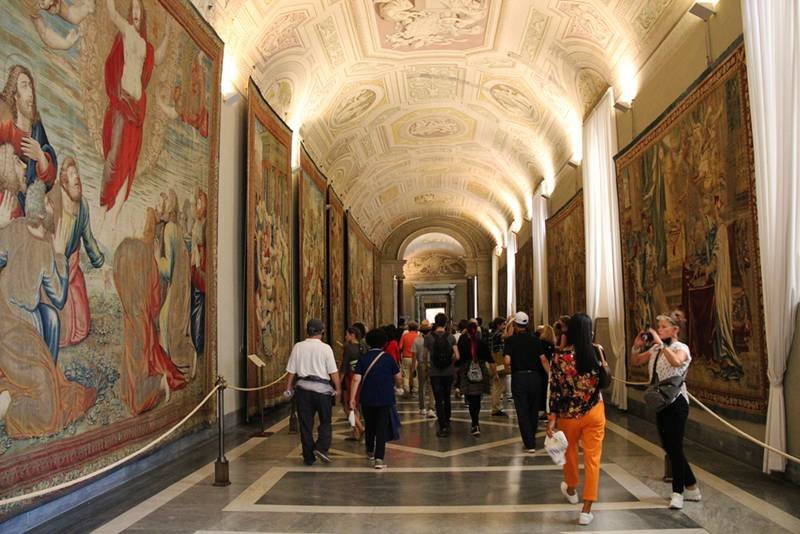The Gallery of Tapestries, or Galleria degli Arazzi, is a captivating highlight of the Vatican Museums, showcasing some of the most magnificent examples of textile artistry in the world. This opulent gallery is a testament to the creativity, craftsmanship, and historical significance of tapestries as both decorative and storytelling mediums.
Located within the Vatican Museums, the gallery features a stunning collection of intricately woven masterpieces, including the renowned Barberini Tapestries.
Visitors to the Gallery of Tapestries are treated to a visual feast that combines the richness of color, intricate detail, and the compelling narratives of Christian art.
About Tapestry Art
Tapestries have long been regarded as one of the most prestigious forms of art, combining functionality with aesthetic brilliance. Originating in ancient civilizations, tapestries reached their zenith in the late medieval and Renaissance periods when they were used to adorn the walls of churches, palaces, and noble residences.
These works of art served multiple purposes, from showcasing wealth and power to providing insulation and improving acoustics. In the Vatican Museums, the tapestries are not only decorative but also deeply spiritual, illustrating biblical stories, the lives of saints, and key moments in Christian history.
The Barberini Tapestries
The Barberini Tapestries stand out as some of the most extraordinary pieces within the Gallery of Tapestries. Commissioned by Pope Urban VIII, a member of the influential Barberini family, these works were woven in the 17th century in the Barberini family workshop in Rome. Known for their intricate designs and vibrant use of color, the Barberini Tapestries depict scenes from the life of Christ, the Virgin Mary, and various saints, blending Baroque theatricality with religious devotion.
One of the most famous pieces in the collection is “The Triumph of Divine Providence,” an allegorical tapestry celebrating the virtues of faith and divine intervention. This piece exemplifies the Barberini Tapestries’ characteristic richness in both artistic and spiritual themes, with figures rendered in lifelike detail against a backdrop of celestial grandeur. The tapestries are further distinguished by their use of gold and silver threads, adding a sense of opulence and otherworldly radiance to the compositions.
Biblical Narratives and Symbolism
The tapestries in the gallery serve as visual interpretations of key biblical stories, designed to educate and inspire the faithful. Scenes such as “The Nativity,” “The Crucifixion,” and “The Ascension” are rendered with extraordinary detail and emotional depth. These works are rich in symbolism, with every figure, gesture, and object imbued with meaning.
For example, the use of specific colors, such as gold for divinity and red for sacrifice, reinforces the spiritual themes of the tapestries. The intricate borders often include additional symbols and motifs, further enriching the storytelling experience.
The Weaving Process
Creating a tapestry of the caliber found in the Gallery of Tapestries was an immensely complex and time-consuming process. The designs, or cartoons, were first painted by master artists. These cartoons were then sent to weaving workshops, where skilled artisans used looms to translate the designs into fabric. The process involved weaving threads of wool, silk, and sometimes gold and silver to achieve the desired colors and textures. The result was a durable and visually stunning work of art that could take years to complete.

Historical and Cultural Significance
The Barberini Tapestries and other works in the gallery reflect the Church’s role as a patron of the arts and its dedication to preserving cultural heritage. These tapestries were not merely decorative but also served as instruments of faith, designed to inspire devotion and convey complex theological ideas to viewers. Their creation and display highlight the collaboration between artists, weavers, and patrons, demonstrating the interconnectedness of art, religion, and society during the Baroque period.
Restoration and Preservation
Preserving these centuries-old masterpieces is a monumental task. The Vatican’s team of conservation experts employs advanced techniques to ensure the tapestries remain vibrant and structurally sound. Restoration efforts include cleaning, repairing damaged threads, and stabilizing the fabric to prevent further deterioration. The gallery’s controlled environment, with regulated temperature and humidity, plays a crucial role in safeguarding these priceless works for future generations.
Where to See It
The Gallery of Tapestries is located within the Vatican Museums, forming part of the main route leading to the Sistine Chapel. Its strategic placement ensures that every visitor has the opportunity to experience this remarkable collection. The gallery’s central location and accessible layout make it a highlight of any Vatican Museums tour.
Visitor Tips
To make the most of your visit, plan to spend ample time in the Gallery of Tapestries. Arrive early in the day or later in the afternoon to avoid peak crowds and enjoy a more tranquil experience. Pay attention to the details of the Barberini Tapestries, such as the textures, colors, and narrative elements, which are best appreciated up close.
Consider using an audio guide or joining a guided tour to gain deeper insights into the history, artistry, and symbolism of the collection.
The Gallery of Tapestries offers a unique opportunity to connect with the artistic and spiritual legacy of the Vatican Museums. Whether you are an art enthusiast, a history lover, or a casual visitor, this extraordinary gallery provides an unforgettable experience that will leave you in awe of the creativity and devotion that shaped these magnificent works of art.
More to Discover at Vatican Museums:
- The Radiant Gallery of Candelabra in the Vatican Museums
- The Majestic Room of the Immaculate Conception
- Saint Peter’s Basilica: The Heart of Vatican City

